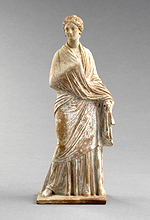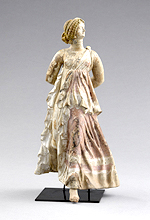|
|

 |
 |
|
In the 1870s, thousands of terracotta statuettes were discovered in tombs lining the roads leading to the ancient Greek city of Tanagra. The site quickly became famous, and the name "Tanagra" entered everyday language, indicating statuettes of a similar style, but which were not necessarily made in the city itself. The figurines' existence was already known, but only now did they begin to attract wider attention. Tanagras were the object of a veritable craze in 19th-century Paris, and a source of inspiration for numerous artists.
|
 |
 |
 |
 |
 |


c. 375-350 BC / H. 21 cm

The Titeux Dancer's lively pose radically altered the accepted view of Greek statuary in Western Europe in the 19th century, and inspired many artists of the day. The Dancer was incorrectly associated with Tanagra, but was in reality made in the ancient city of Athens, the capital of the Greek region of Attica. The figure's elegant lines, and the delicate handling of the folds of her cloak, herald the "Tanagran" style which would appear in Athens a few years later, then spread to Tanagra and the whole of the Mediterranean basin. The statuette is traditionally identified as a dancer, but she may equally represent a Nymph, the protectress of brides-to-be. |
 |
 |
 |


c. 330-200 BC / H. 25.3 cm

The terracotta figurines were placed in temples as offerings to the gods, or in tombs. The Woman with a Cloak was discovered in a tomb in the city of Tanagra, in the ancient region of Boetia. The statuette represents a typical "Tanagran" subject – the draped figure of a woman. The statuette's elegant, sculptural form despite her small size, and the beauty of the drapery make this a highly successful representation of the human figure, reflecting two central themes in ancient Greek statuary – the female body, and feminine garments. The influence of the Greek sculptor Praxiteles, who was active in the 4th century BC and is credited with the introduction of several female figure types, is clearly apparent in the handling of the drapery, and the pose. |
 |
 |
 |


c. 150-100 BC / H. 42 cm

During the Hellenistic period, following the conquests of Alexander the Great, Tanagra figures spread throughout the Greek world, around the Mediterranean basin, and in particular towards the Orient. Myrina, an ancient city in Asia Minor (modern-day Turkey), adopted the Tanagran style and subsequently developed what may be termed a "post-Tanagran" style, illustrated here by the Phainomeride Figure. The figure is part of a group of 30 items discovered inside a sarcophagus in a tomb in Myrina. The figure's size, the handling of the drapery, the movement of the body, and its fresh colors make this a truly remarkable work. The pose is closely similar to that of winged figures representing Nike, the Greek goddess of Victory. However the position of the arms, folded behind her back, support suggestions that a second figurine may have been fixed here, thereby creating a group of figures playing the ancient Greek game ephedrismos, in which the loser carries his or her adversary upon their back. |

| Tanagra, Musée du Louvre, Paris © Photo DNP / René-Gabriel Ojéda |
|
 |
|

